Come O Visitor
Pierce the Shroud and see,
What Chandras holds in store for thee.
Chandran Chorus
The Chandras Galaxy is a mysterious satellite galaxy to the Quadrant Galaxies, part of the Cyrandia Cluster and thus of the larger First Gigaquadrant. It's existence came to be known the universal community barely a few years ago when its local superpower, the Singularim Pact, traversed the wormhole network in Cyrandia to battle the Galactic Empire of Cyrannus.
In reality, Chandras is a galaxy that has had a much larger purpose in ancient times. It was the bastion of the Krassio Host during the worst years of the War of Ages. Its cosmic properties are entangled with the powerful Psionic Essence, with spirits born out of this energy, called Iluvii, manifest occasionally and roam freely in its space: Where the ruins of the ancient and cryptic Krass abound, and where the devastation of great wars has left a good portion of it to anarchy.
Chandras is a galaxy in recovery, its denizens looking up to a brighter future despite the piracy, the interdimensional threats and savages that assail the enduring worlds that surivived the War of Ages (or Demon Wars as Chandrans call them) and the Great Psionic War, which blasted a great portion of the galactic North, leaving it barren of the majority of stars.
To arrive to Chandras is akin to making your first steps into a mystical land, where fleets of Pilgrims traverse the cosmos in search for enlightenment, scavengers and archeologists dig the abandoned ruins and forsaken megastructures of the Krassio during the Great Psionic War, where traders brave the void of space filled with banditry, and where being a warrior defines your survival.
Nevertheless, Chandras is the cradle to the most powerful warriors the universe has ever known: the Krassio, who now attempt to fulfill their ongoing mission to protect the universe from the clutches of Chaos.
History[]
The Pentjuan Age is a prehistorical time in Chandras from which modern knowledge is still vague. This age, however, is known by Chandran scholars to be the time before the arrival of the Krass—another quite loose time in Chandras' history—, detailing its creation and the arrival of the Iluvii.
Primordial Times[]
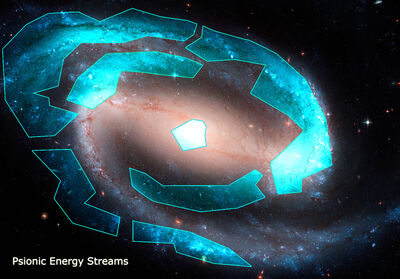
The Psionic vergences that allow the galaxy to be strongly connected to the Iluvii Realm are an object of deep study among psionic scholars.
Chandras stands as a mysterious galactic body, normally a rumor among other gigaquadrantic communities due to most of its history being based on pre-modern history.
The galaxy's origins are enigmatic, as the first record of its existence dates back to the aftermath of the Tigris War, where the Krassio first discovered it. However, the late Krassio Host made astonishing discoveries once they started spreading their influence across the galaxy. The first and most obvious was that Chandras has a unique connection to psionic essence, enhancing the powers of a user ten-fold. The reason for this is unknown, as there are no records of any other galaxy in the universe with these traits, which despite superficial evidence of spontaneity, show incredible artificial essence manipulation as if the entire galaxy was just forced to merge its physical traits with the Iluvii Realm. Psionic spirits roam the galaxy, either alone or en masse, creating a unique galactic eco-system. Almost all of the space-faring civilizations have benefitted from the raw psionic essence at their disposal, developing reverse-engineered psionic jump drives for FTL travel, and even psionic shielding in some cases.
The Krassic Age is a prehistoric time in Chandras from which only a fraction of things are actually known by modern scholars, yet this age concerns the golden age of the ancient Krass, their rise and eventual demise millions of years ago.
Krass Hegemony[]
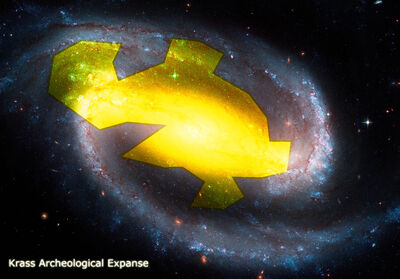
An estimate of the extent of the Krass Empire in Chandras.
The second discovery the Krassio made was the evidence of two prominent species in ancient times colonizing the galaxy: the Krass and the Grox. However, both of them arrived at different periods of time and have long abandoned their settlements. The Krass were not an innate psionic species, unlike the Krassio, but their presence there indicated that the Krass might have researched Chandras' unique affinity to psionic essence to imbue it within the Krassio, which made the latter civilization realize that in some way, Chandras was their spiritual, ancestral home.
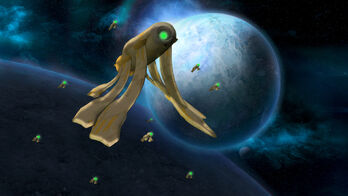
A Krass fleet traversing Chandras
The Krass dominated the core regions of the galaxy and presumably extended into the mid rims, although the full extent of their influence in Chandras remains at large, it is presumed that they heavily influenced the cultures and minor civilizations that existed at the time, serving as an effective deterrent for foreign powers that sought to impose other ideals different to them. The Krass Empire left a lasting set of ruins following their collapse as a civilization.
The Krass hegemon collapsed upon itself due to mysterious infighting that brought down their population to scarce numbers. There are no records of Krass leaving nor becoming extinct all of a sudden, which makes many scholars imply that the Krass chose to die in peace and silence, secluding themselves from the wider universal community and eventually dying out.
The Interludian Age is what Earth's Ancient History would be to Chandras, marking the beginning of pre-modern recorded/written history for the known species inhabiting Chandras.
The millions of years that followed the decline of the Krass Empire, no other major civilization was known to become a superpower, civilizations rose and fell, leaving a community of peoples that rarely interacted with each other and that cared only for themselves and their own versions to the Mythos surrounding their home galaxy. Spirits still roamed free, influencing minor civilizations to follow their lead towards the Iluvii Realm. In some cases, these worlds often managed to shift out of existence and never return.
It is said that the Li Combine arrived nearly 2000 years before the advent of the Krassio, escaping the onslaught of demonic forces and finding asylum in the galaxy, marking the beginning of their apparent supremacy over the galactic west.
The Krassiozoic Age marks the arrival of the Psionic Lords, the Krassio, into the galactic theatre. Their coming heralded an uplifting era where the galaxy was fully awakened by Psionic Essence, and the galaxy was united under its benefits. It is the modern and present time in Chandras in relation to other galactic communities of the First Gigaquadrant.
Arrival into Chandras[]

Krassio Host's peak colonized/annexed territory.
After the loss of their own home galaxy, a psionic portal opened in the far galactic west of Chandras, and from it poured a gigantic fleet belonging to the Tigris superpower known as the Cianju Alliance. The Cianju, now reformed into the Krassio Host, quickly asserted its dominance across the galaxy by influencing the minor civilizations located there, even quickly annexing the then powerful Li Combine. The Krassio Host's sole purpose was to use the galaxy's lost technology and innate psionic energy sources to power their war machine, even using their protectorates across the galaxy as cogs in their huge war industry to campaign against the onslaught of the revived Dominion of the Xhodocto.
Despite the then ruthless methods of the Krassio, their co-belligerents, and proteges, during the War of Ages lived with contempt and enjoyed high living standards, following their teachers and protectors blindly towards their ultimate goal of defeating the larger demonic invasion occurring across the universe.
In the end, the Krassio Host's supremacy over Chandras would lose its grip following the Annihilation of the Xhodocto, which forced the Krassio out of the gigaquadrantic landscape and saw their numbers greatly reduced, unable to retain their hold over their protectorates. Soon, the seeds of another conflict would arise, as some Iluvii spirits that had secretly watched the Krassio from afar began to plot their destruction.
Krassio-Xol'Etra War[]

The Xol'Etra rapidly capitalized over the Krassio's depleted forces to crush them from two sides.
In an event that is also called 'The Great Hunt', Chandras suddenly awoke. Psionic spirits long-dormant began to rise from the Iluvii Realm and gorging out of portals that appeared across the extension of the Krassio Host's territory. A group of Iluvii spirits who called themselves the 'Xol'Etra' had foreseen what the Krassio would become if left unchecked and thus began a war of persecution and extermination, calling it 'containment'.
Thus, Chandras saw its first major war in millennia.
The Xol'Etra breezed through, converting many of the annexed worlds by the Krassio against their former benefactors under the gospel of being psionic gods. Never in Krassio history had they witnessed a real Iluvii spirit, believing that they were the only denizens of the psionic realm.
The Krassio-Xol'Etra War was short, with the advent of the annihilation shaping the very fabric of reality, the Krassio were only spared by the works of their leader, Master Kroc, who hid them beyond the Xol'Etra's reach. A group of Krassio secluded themselves in the Beacon Sector of the Endless Space, a long-range cluster of systems orbiting the Chandras Galaxy. Another group was salvaged in a pocket dimension, called the Primal Armada. The Krassio left the galaxy in control of their new rulers, the Xol'Etra, and so began the age of the Xol Dominion.
Xol Dominion[]
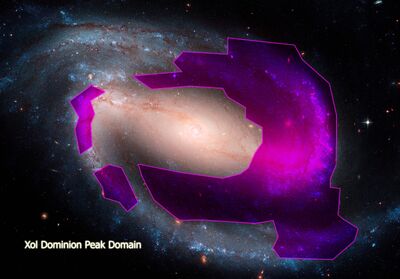
The Xol'Etra's rule was one known for its cohesion and stability, with a focus on order via a harsh and strict imperial cult.
The galaxy trembled as they saw the mighty Krassio defeated by a force usually reclused to sporadic manifestations of the Iluvii Realm. The arrival of the Xol'Etra marked the beginning of the end of the Golden Age of the Krassio, as the former occupied the latter's settlements and space structures, invaded their protectorates, and subjugated them under an imperialistic rule, declaring that the Children of Stars were none other than them.
What followed was known as the Xol Dominion Era, or simply the Xol Era—albeit for others, more liberal in mind like the Ramion and the Pard, it was majorly dubbed Chandras' "darkest of times". This period of time was heightened by the forceful imposition of the Xol'Etra's own pseudo-religion, a spiritual divinization of themselves through a complex psionic entanglement that bound them all together called the Pharia. The worship of the Xol'Etra and the Pharia endorsed the creation of the Dominion's religious army of the Phar'Servia and the feudal administration of the vassals it directly controlled. The little chaos and rebellions that ensued following the banishment of the Krassio quickly quelled thanks to the Xol unity and religious fervor, and a sense of stability and secure trade routes across the galaxy were established, however under the yoke of high taxation and tithes to the power-hungry "Psionic Lords".
Military speaking, the Xol Dominion had enough power to project softly their influence across the galaxy despite not controlling it entirely. It allowed the continuing existence of the Tyr Empire and the Xochi Trade League as partners but banned the worship of the Tyr Emperor as a god—a direct affront to Dominion creeds and heavily imposed commercial agreements on the Xochi, which created a rising tension between the two sides. Nevertheless, neither the Tyr nor the Xochi could directly challenge the Xol'Etra, as their Iluvii spirit army and the Phar Servia were formidable, second only to the Krassio's warrior culture.
For the Xol'Etra and its loyal vassals, it was peace eternal; for the rest of the galaxy, suffocating oppression.
Xol Decadence[]
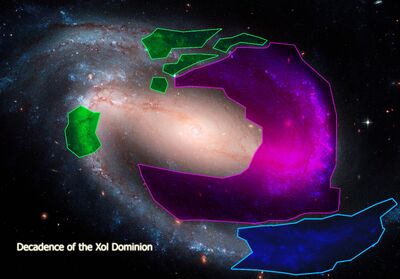
The arrival of the Lorons and the Kraitoss Rebellion weakened the Xol Dominion's position in the Galaxy.
The high taxation, preferential treatment of its subjects based on loyalty, and the oppressive consequences of crimes such as heresy and direct disobedience to the Psionic Lords took their toll on the galactic community, but there was no might that could possibly challenge the Xol in their own terms—psionic mastery. The Krassio had been gone for years and the Tyr and the Xochi, the only capable fighting forces in the galaxy, were not willing to take the risk of falling prey to the zealous onslaught of the Phar'Servia.
An opportunity, however, arrived when a massive fleet of Lorons, aliens from the Otzello Galaxy bent on endless warring, warped into Chandras from the Reach, a remote region to the Galactic South. With relentless violence, the Lorons—naming themselves the Kandrraz Bandz, launched a disjointed series of raids and planetary bombardments across the Xol systems in the region, challenging the Xol'Etra. The Psionic Lords had taken the Krassio by surprise, but they were not really apt to face a civilization battered and strengthened by the devastating War of Ages.
Although the Xol Dominion managed to halt the Kandrraz Bandz at the limits of the Hallow region, the heart of their territory, they were never able to recover the foundry worlds of the Reach, which fell to Loron hands and further cemented their position. Since then, the Reach has been always declared an off-limits zone or a Loron-infested zone by others.
The sudden war against the Lorons withdrew many assets from other parts of the galaxy so as to contain the Crisis and is if were not enough, seeds of discord between the Iluvii spirits began to sow. Kraitoss, arguably one of the most ancient Iluvii ever to manifest in the psionic realm, incited a rebellion not only by Iluvii spirits but by the Ramion Concordat and the Pard Polity, two nations that had been conquered by the Xol Dominion during its initial expansion efforts and that had suffered the sheer brutality of their concept of order. As the Loron fleets distracted the bulk of the Dominion in an effort to contain their onslaught, a coalition of Ramion, Pard, and the Iluvii (who would later call themselves the Xol Iluvist Order) led by members of their species began a guerrilla war against the larger and still well-equipped Dominion. The rebellion lasted for years and managed to get a grip on several sectors of the galaxy, but it was always forced to remain hidden from the Phar Servia due to a lack of firepower.
All of these events weakened the Dominion's power to control not only its unfaithful vassals but the powers that lied to the West, such as the Tyr Empire and the Xochi League. Tensions rose between the two sides of the galaxy, increasingly prompting a full-blown war between the two parties. However, as the Loron threat was eventually contained, any talks about rising up in arms and directly challenge the Xol'Etra quieted down for some time, as the Phar'Servia and loyal forces of the Xol Dominion swiftly returned to their original posts and began to track down the rebel cells, squashing many.
It would seem as if the Xol Dominion's time would prolong itself indefinitely, if not by the timely return of the galaxy's original rulers.
Great Psionic War[]
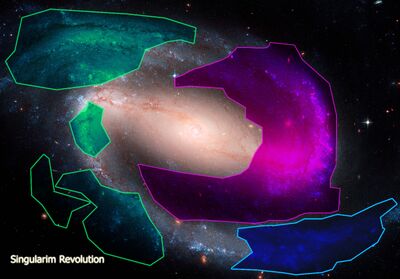
Galvanized by Singul'Aren, many sectors of the galactic West began a massive uprising against the Xol Dominion, led by the long-exiled Krassio.
From the Endless Space between galaxies, most precisely to the galactic North by the region that would later be called the Sanctum, a sizable fleet of Krassio vessels from the time of the War of Ages warped in and began prompting systems to their cause: to depose the Xol'Etra and bring freedom to all. Their claim of liberty and true order was not unfounded. For many years, rebels had tried to challenge the Xol'Etra, but their psionic might through the Pharia had been too great for any freedom fighters to resist indefinitely. With these new insurgents came Singul'Aren, self-proclaimed Allfather to the psionic people and god of balance—a true god, unlike the spirits back in the Dominion. Indeed, his power was enough to challenge the might of the Pharia and finish its oppressive, all-consuming presence.
The revolution did not go well at first, for the revolutionaries did meet with the best warriors the Dominion had to offer, as the Xol'Etra recognized the threat of the Krassio. However, when the Xochi Trade League and the Tyr Empire officially sided with the cause, the cards were set, and countless warships from both sides met each other in a massive battlefront. All-out war had erupted, either the Dominion or the revolutionists named Singularim would fall in this destructive conflict.
At first, it all seemed to be a war of attrition, whereas he who would possess greater resources and weaponry would win the battle. However, the Xol Dominion had been suffering from a slow decadence since the arrival of the Lorons. The Xol'Etra had begun to feed more power into the Pharia in order to power up servitors and battle the rebels, but unbeknownst to them, the Pharia had gained sapience, turning into a malevolent god of unimaginable power and above all, thirst. Without them noticing, the Pharia had begun to leech the power of the Xol'Etra, rendering them weaker little by little. The death toll in the war reached its toll when the Dominion, desperate to hold the Singularim advance, imploded a great portion of the Northern sectors of the Chandras Galaxy, seeking to deny the rebels possible bases and new worlds where they could get more fighters. The Ramion Concordat lost a third of its original territory in the process, and the region that was born from it came to be known as the Torn—a crack in the galaxy that will forever remain as a testament to the atrocities of the war.
As the Singularim mourned over the countless dead, a new entity arose from the slaughter, a spirit of vengeance that was so engulfed by the cries of innocents, it coalesced and formed into a new god, Ynur'Vae. With two gods now backing the revolutionary forces, the Dominion finally began to retreat battle after battle. The tide, however, was turned when Singul'Aren managed to rescue imprisoned Krassio troops, the Primal Armada, led by the Civatron Hierarch known as Kroc. With the Civatron leader and his elite forces joining the fray, the Dominion was swiftly pushed to the point where they were defending their very capital, Vof Valar.
The siege was brutal, lasting years, with neither side being able to break it. A turning point for this key battle was the sudden summoning of Yasuul forces, evil Krassio from another dimension, who began to tear the Xol forces within the Solar system-sized city. The battle was fierce, as the Singularim and the Xol signed an armistice and a brief alliance to deal with the extra-dimensional threat. Many forces from the Yasuul Legion managed to escape a tight blockade by the Singularim forces, releasing their evil whims to the galaxy.
The battle was over, and the Xol Dominion was held against the wall. The armistice relinquished all of the empire's vassals except those who willingly wanted to remain with them. The Xol'Etra vanished, devoured by the Pharia—their very creation—allowing for the Dominion's denizens to look inwards, reform themselves, and ultimately survive. The revolution members, however, sat together and discussed the possibility of a permanent alliance.
Singularim Pact[]
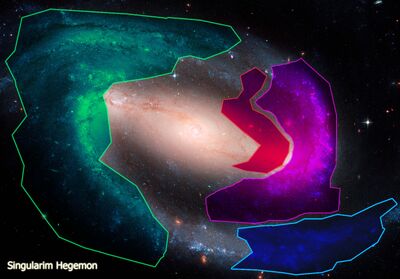
The result of the war, albeit devastating, brought a new superpower to light, one that held a solid military to protect itself from the rising dangers of the galaxy, but lacking the cohesion of the Xol Dominion.
This is the present era. An age that has been signaled by trying times, as half of the galaxy either burns by the embers of the Great Psionic War or lies at the peril of savages such as the Loron.
The members of the initial Singularim Revolution convened in council and decided to form a new alliance that would protect them all in case of future threats, either galactic, extra-galactic, or even extra-dimensional. Through the guidance of the Krassio, who was the most experienced faction in terms of sizable military alliances, the Singularim Pact was born. Due to its militaristic and oligarchic nature, the Pact favored its main members over any minor signators, but it ensured secured borders and the possibility of a new identity as a nation looming in the near future.
Singul'Aren stepped down from the revolutionary leadership and committed himself to teach at the core of the Krassio territory as a caring Allfather and nurturing teacher to the countless Pilgrims that flocked to him in search for psionic tutelage. Iluviism came to be a central religion in the galaxy thanks to his efforts. Meanwhile, Kroc—who also began to refer himself as Anur'Ctar—assumed leadership of Krassio armies and the new Pact Grand Armies. Kroc became General-Commissioner, whilst Ynur'Vae became the Lady Protectress of all the dead, the lost, and those seeking retribution in a galaxy turned asunder by the scorch of war, leading her own order of warriors known as the Lady's Lords.
The Pact has not been perfect in its hegemonic rule over Chandras, as its members seek to topple one another in a clever game of politics, espionage, and even some skirmishes here and there. The Krassio remain a good deterrent to prevent any major conflicts in the galaxy, and the crisis of the Lorons, the Yasuul, and other dangers are being dealt with by the joint forces of the Xolarum Republic, the Lankrass Alliance, and of course the Singularim Pact, the three considered to be the big three powerhouses of Chandras' galactic community.
Recently uncovered Krass technologies have enabled the Pact to began terraforming planets back into their original state so as to recover what was lost during the war, or what little is left. Rumors of unrest among the Krassio resonate across the galaxy, and even in the aftermath of the Great Psionic War, the seeds of a new conflict are beginning to arise, threatening the loose order that has begun to bloom in Chandras.
The Mellonian Age is the name given by prophets and scribes that have received visions of the future. Divergent timelines come and go, creating endless possibilities for the future of the galaxy. But these timelines seem to converge in a far distant future, the Méllôn, as they call it, a place in time that few seers have used their precognitive abilities to try and touch—this mysterious convergence of all timelines—only to be pushed back and lashed out, drained of their will and mind.
No events from this Age have ever been recorded or witnessed as of now.
Political Overview[]
From a political perspective, Chandras could be currently considered as a war-torn community, as the ruins of the ancient Krassio's hold over most of the galaxy lie everywhere to be sighted and beheld, yet broken and unable to be restored again following the Great Psionic War. Still, nations and alliances are forged to retrieve lost technologies or weapons from the golden age of the Krassio Host, arms and powers designed to bring total war to the enemies of the universe.
The political balance in the galaxy lies altered, disturbed, as the fires of the revolution still burn over several regions of Chandras, like the Torn, the Hallow, and the Unhewn still harboring rogue or alien forces like the Yasuul Legion, brigands of corsairs sanctioned by the Xolarum Republic and even chaotic cults that have managed to establish strongholds in some systems. The Reach is a Loron-infested region, with their fleets sporadically jumping on the neighboring region to pillage and raid the increasingly wary colonies there.
The safest place in the galaxy, by far, lies to the galactic West, where the Singularim Pact's members and combined military provide a sense of order across half the galaxy. Still, due to the Grand Armies of the Pact being only able to act when at war against foreign powers or suppressing chaos-related rebellions, the Council members of the Pact have gone through a swift process of militarization, using the wealth of their particular spheres of influence to amass their own national armies apart from the Grand Armies of the Pact. As result, there are, presently, three different military factions that do not answer to each other and that do not form part of a single cohesive force (albeit represented as united on paper): The standardized Grand Armies of the Pact, each nations' armies, and the Iluvii Spirits (which represent a large, independent force loyal to the Krassio forces). Although these three military presences have never engaged one another in large conflicts, rumors of disputes and small skirmishes slip around the tongues of merchants and travelers, speaking of unfortunate occasions that reflect the disparate interests within the Military Junta. It is safe to say that, despite conflicting agendas, the Pact remains united because—one way or the other—the Krassio's undying goal of protecting the universe serves their goals right.
Galactic Division[]
Here is a simplified map of the territory held by all large nations within Chandras, as well as their affiliation to one of the three main powers or alliances: The Singularim Pact, the Xolarum Republic, and the Lankrass Alliance.
Astrography[]
Drawn out not because of cartographic simplicity or astrographic logistics, Chandras is normally divided among its denizens based on the type of cosmic region that permeates said areas. Stellar phenomena, gravity distortions and, perhaps most important of all, essence-based anomalies are taken into account in order to determine a region's safety. Sometimes the overall distance or remote location of one region influences its naming, and in other occasions, such as the case of the Hallow, Sanctum, and Seat regions, it is the type of inhabitants or ancient megastructures the ones that define their christening.
The astropolitical activity in Chandras currently lies in two main regions; the Sanctum, where all religious and essence-based affairs are normally addressed, and where the Krassio settlements lie; and the Seat, where four of the Great Members of the Singularim Pact have vied for supremacy over one another for centuries and since the end of the Great Psionic War, has become the center-stage for political and economical affairs.
Currently, travelers from other galaxies will find that the most structured and ordered end of Chandras would lie in the galactic West, where the Singularim Pact holds its jurisdiction. The galactic East, in contrast, has turned into a turmoiled end, and although there are prominent regional powers such as the Xolarum Republic and the Lankrass Alliance, the worlds of that other side of the galaxy are usually raided and terrorized by the onslaught of Lorons from the Reach and constant incursions from Dark psionic users known as the Yasuul.
Deep within the systems closer to the galactic core, there is nothing but silence and ruins of Grox and Krass nature. All the planets there are dead, empty husks with nothing more than small hints of cities or space stations ever existing there. Whatever happened to them remains a mystery, for the area in itself brings dread and terror to even the bravest of the explorers and adventurers.
Species[]
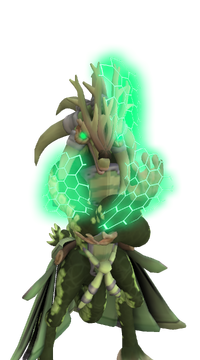
Despite being the least populous species in Chandras, the Civatrons control either directly or indirectly a vast majority of the galaxy via the Singularim Pact.
Chandras, despite its recent devastation to constant fighting from the Pact and the Dominion, still thrives with species that had managed to prosper during the hegemony of the Dominion. Many of the dominant species in Chandras are intergalactic immigrants from ancient times, making them alien to Chandras.
With three different organizations controlling vast portions of the galaxy, the Krassio have ruled over Chandras with a militaristic vision, seeking to uphold the utmost beliefs in their mission to protect the universe. Whether they have been a good or evil to the galaxy, none can truly say, as history has been greatly marked and shaped across the centuries by the Psionic Lords
Despite their respective allegiances to major factions, each species holds a degree of opinion for the others. Official allies in paper could be potential rivals and enemies in reality. This does not abide to all members of the species, and despite stereotypical roles bestowed to the entire race, some individuals escape this sense of determinism in their species' culture by choosing a different path in profession or in lifestyle.
Due to the properties of the galaxy itself, many of the species in Chandras experience a phenomenon called 'the Glow'. As the name states, it causes certain body parts to glow in intense display of psionic energy. This glowing feature is also named the Boon due to its positive adjustments to the species after different generations. The Glow is, technically, a mutation caused by exposure to this type of Essence, so far known to bring blessings upon the mutated rather than curses.
Economics[]
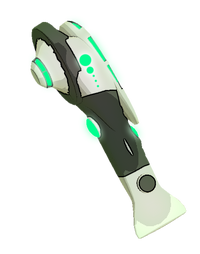
Most denizens of Chandras use a variation of the Matter Manipular, which allows them to manipulate matter at their whim to create commodities from a subatomic starting point.
In the times of the War of Ages, and even in the age of the Xol Dominion, a Krass-influenced culture of solar harvest—a tradition lasting millennia—came abruptly to an end in the aftermath of the Great Psionic War. The Xol'Etra, maddenned by their god and seeking to deny the Singularim revolution a huge region of star systems between the now called Sanctum region and the Hallow region, caused a gravitational collapse of the region, in which they used literal stars and their cosmic satellites to bombard the revolution forces. The result was the near destruction of the galaxy's most populous region in terms of habitable systems, which in turn launched the galaxy in an uncontrollable set of gravitational tides and destructive cosmic winds that still cause mayhem and devastation to this day. Its most significant damage, however, was the obliteration of a large energy resource due to the wipe out of common stars, dyson spheres destroyed and a large amount of Hydrogen, as unquantifiable as it is, vanished (along side Helium). This destructive cascade also affected the galaxy on a technological level, as high-point technology is used by powerful factions such as the Singularim Pact, but those non-aligned strive hard to acquire energy.
In the Chandras Galaxy, Plasma is quantifiable in their own exotic measurement: the Iazu (plu. Iazii), which, in terms of physical volume, would be the equivalent of a minuscule drop, thus many denizens in the universe refer to their currency as "Drops". The value of a drop depends of its consistency, meaning that Iazii conformed of Hydrogen are less valuable than the highest bidder: Iluvium. Iazii are stored by the Matter Manipular, a basic tool that comes in all forms, capable of storing a certain number of Iazus depending on the upgrades the device receives. The Matter Manipular can pay using the Iazus or convert the Plasma into matter transformation processes, such as food and construction materials.
Only one Drop of Hydrium Plasma is enough to process energy for an entire metropolis, and so the poorest levels of society struggle to gather plasmic particules due to a lack of tools to gather it.
Society and Culture[]
Society[]
“Clarity of mind, friend.”
- - A Chandras greeting among the commonfolk.
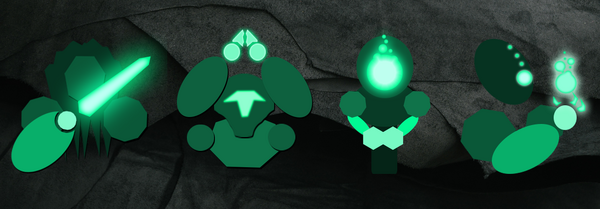
The four most prominent 'Callings' in Chandras. From left to right: Warrior, Arconaut, Pilgrim, and Trader.
It is clear that both society and culture in the galactic community have been influenced by two major factors: Psionics and War. As devastation plundered countless worlds due to planetary bombarments or massive frontlines—needless to say the solar destruction of countless systems in the Torn— a rule of survival of the fittest has begun to pervade the desolated areas of the galaxy whilst a more militaristic lifestyle has taken hold of the most organized and reconstructed societies such as the Singularim Pact, not to even mention the Warrior culture of the Krassio. To learn how to fight is essential in Chandras, as it may not only save your life, it might grant you a better quality of it.
Many follow the path of the Warrior established by the Book of Discipline and live an honorable life, greater numbers enlist in the vast military of the Grand Armies of the Pact, yet countless more use their martial skills for a life for hire, protecting crucial caravans that connect the worlds stranded in hostile space and serve local rulers and nobility as bodyguards—or defenders—of these same planets, sometimes systems. However, there is a large portion of Chandras, particularly the unruly galactic South, that commit their skills to more dishonorable and devious acts such as piracy and the forming of strong bandit cabals, with the presence of the Kandrraz Bandz in the Reach subtly endorsing such practices due to their constant warmongering.
Second to the warrior profession is the Caravaneer and Trader, for fighting skill and martial knowledge and experience might save one's life for a day, but the works of bringing supplies to the far reaches of the galaxy and inhospitable outposts prolongs the life span of a settlement indefinitely. These merchants form up in sizable flotillas of caravaneers, armed to the teeth and some even protected by experienced mercenaries or altruistic warrior orders, and roam the galaxy, maintaining the flux of commerce by purchasing and selling goods, providing much needed energy and keeping entire communities alive. The range of goods and commodities these traders bring to stations, ports and cities in the outer fringes of space—even the most populous areas—is limited only to the niches they focus on. A trader could focus on the exchange of energy, granting access to higher and more durable energy sources to outlying outposts, or they could base their trade in the hiring of warriors for them to defend these colonies for a sustained fee. Nevertheless, it is said that traders are the lifeblood of Chandras, and merchants all around the galaxy are well-respected individuals, second only to a reputable or legendary warrior, althouth the latter's influence might be more abstract than pragmatic.
Behind the profession of trader is the Arconaut, a glorified name for the scavengers that seek to retrieve the secrets of the immense arcologies, megastructures, and monuments of war from past conflicts, either from Krass or Krassio origin, many of which where left abandoned, unmanned, yet maintain themselves through the works of the cryptic Neural Physics—capable of eternally existing due to metaphysical foundations. As such, the Arconaut can be brought forth by a range of other professions: historians, archeologists, scholars, scientists, pilgrims, warriors, or even the traders themselves, the Arconauts made their life's work to retrieve technology thrown into oblivion in order to either repurpose it for their own purposes or to trade in order to make a living, to survive. In part, the Arconauts that scour the galaxy in search for artifacts can bring a certain relief to communities next to these colossal structures floating adrift near a sun, a black hole or any other stellar formations.
Finally, there is yet another type of calling in Chandras that shines bright yet does not bring any practical solutions to the problems of the galaxy, as it feeds from the Psionic Essence pervading the galaxy and contribute to it due to their spiritual practice. The Pilgrim is a person who has either traveled from a point in Chandras or from other galaxies through psionic vortexes in order to commune with the Iluvii Pantheon in one way or another. It is as common to see a caravan of Pilgrims—most of them gifted students of essence and capable of defending themselves—as it is to witness a flotilla of traders or a fleet of warriors. These Pilgrims travel in their personal or collective journeys, often visiting locations of psionic interest, such as the appearance of a psionic stream of energy with a herd of Iluvii spirits in it or the residual psionic signatures of a battle involving the Krassio. Pilgrims are usually devoted adherents to Iluviism, believing the Krassio to be demi-gods sent by the gods (or a variant version of this doctrine) and worshipping them with holy fervor. However, the highest concentration of Pilgrims lies in the mobile planet of Praxeum, constantly phasing in and out of reality and into the Iluvii Realm. Countless individuals gather there just to glimpse or receive a touch from their gods, summon Iluvii spirits and bind their lives to them, or train under Krassio masters and other psionic teachers. If the Warrior is to be the muscle of the galaxy, the Trader its lifeblood, then the Pilgrim is perhaps the Spirit of Chandras itself.
Chandras, albeit a small galaxy, is still vast in its population, diverse in its traditions, and varied in its callings. Some professions and traditions may rise above others in terms of importance, but the denizens of Chandras feed its galactic community with a rich cultural background and set of codes that are hard to pinpoint.
Culture[]
“Our minds are like open letters.”
- - Chant among psionics upon performing the Melding.
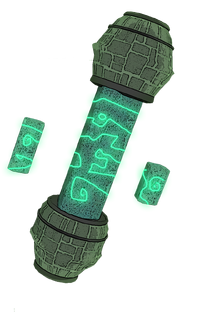
Most of the lore of Chandras is stored in Memorialist Codexes, the prime example being the Book of Discipline, the concept of writing or recording has been long abandoned, instead recording their thoughts for storage of knowledge.
Technology and Science[]
Religion[]
Notes[]
These are notes and trivia written by the main author of this page: The Valader.
- Chandras Galaxy is the seat of The Valader's retcon fiction (as of 2018).
- Chandras draws inspirations from the novel Dune by Frank Herbert, the Koprulu Sector from Starcraft by Blizzard Entertainment, the Foundation Series by Isaac Asimov, the Warhammer 40k Universe by Games Workshop, and the videogames Kenshi by Lo-Fi Games and Caves of Qud by Freehold Games.
- In the first iteration of Chandras, the galaxy was supposed to be placed in another universe. This concept is still used at times to describe Chandras' unusual positioning near the Quadrants, but it is a detail never mentioned by the denizens of the galaxy, not even by the Krassio (who predate the Fictionverse cleanslate), having seemingly forgotten about that detail alltogether as if erased by the Xhodocto.
- Note that much of the information given in this page is also set as in a Lore Book of an RPG game. The Valader developed it in this way so that the readers might have a more in-depth yet simple understanding of how an individual would act in Chandras.








